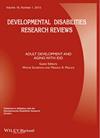Dana Frisch, Michael E. Msall
{"title":"Health, functioning, and participation of adolescents and adults with cerebral palsy: A review of outcomes research","authors":"Dana Frisch, Michael E. Msall","doi":"10.1002/ddrr.1131","DOIUrl":null,"url":null,"abstract":"<p>With medical advances, more individuals with cerebral palsy (CP) syndromes who reside in developed countries are surviving to adolescence and adulthood. However, there continues to be a paucity of research examining long-term health, functional activities, and participatory outcomes over their life-course. This article reviews the current literature assessing adult outcomes for individuals with CP within the framework of the International Classification of Functioning (ICF), Disability, and Health model of enablement. Preliminary data over the last decade indicate that among adults with cerebral palsy without intellectual disability, 60–80% completed high school, 14–25% completed college, up to 61% were living independently in the community, 25–55% were competitively employed, and 14–28% were involved in long term relationships with partners or had established families. These outcomes occurred with biomedical advances in the management of spasticity, deformity, and medical co-morbidities, as well as with concurrent policy initiatives to increase access to a continuum of habilitative and education services. Although we have incomplete population data to inform comprehensive life-course planning, there are opportunities to create clinical and translational community networks with improved measures of functioning and participation that can better inform us about the factors influencing lifespan development of people with CP. © 2013 Wiley Periodicals, Inc. Dev Disabil Res Rev 2013;18:84–94.</p>","PeriodicalId":55176,"journal":{"name":"Developmental Disabilities Research Reviews","volume":"18 1","pages":"84-94"},"PeriodicalIF":0.0000,"publicationDate":"2013-08-16","publicationTypes":"Journal Article","fieldsOfStudy":null,"isOpenAccess":false,"openAccessPdf":"https://sci-hub-pdf.com/10.1002/ddrr.1131","citationCount":"45","resultStr":null,"platform":"Semanticscholar","paperid":null,"PeriodicalName":"Developmental Disabilities Research Reviews","FirstCategoryId":"1085","ListUrlMain":"https://onlinelibrary.wiley.com/doi/10.1002/ddrr.1131","RegionNum":0,"RegionCategory":null,"ArticlePicture":[],"TitleCN":null,"AbstractTextCN":null,"PMCID":null,"EPubDate":"","PubModel":"","JCR":"","JCRName":"","Score":null,"Total":0}
引用次数: 45
Abstract
With medical advances, more individuals with cerebral palsy (CP) syndromes who reside in developed countries are surviving to adolescence and adulthood. However, there continues to be a paucity of research examining long-term health, functional activities, and participatory outcomes over their life-course. This article reviews the current literature assessing adult outcomes for individuals with CP within the framework of the International Classification of Functioning (ICF), Disability, and Health model of enablement. Preliminary data over the last decade indicate that among adults with cerebral palsy without intellectual disability, 60–80% completed high school, 14–25% completed college, up to 61% were living independently in the community, 25–55% were competitively employed, and 14–28% were involved in long term relationships with partners or had established families. These outcomes occurred with biomedical advances in the management of spasticity, deformity, and medical co-morbidities, as well as with concurrent policy initiatives to increase access to a continuum of habilitative and education services. Although we have incomplete population data to inform comprehensive life-course planning, there are opportunities to create clinical and translational community networks with improved measures of functioning and participation that can better inform us about the factors influencing lifespan development of people with CP. © 2013 Wiley Periodicals, Inc. Dev Disabil Res Rev 2013;18:84–94.
青少年和成人脑瘫患者的健康、功能和参与:结果研究综述
随着医学的进步,生活在发达国家的更多脑瘫综合征患者能够活到青春期和成年期。然而,对他们一生中长期健康、功能性活动和参与性结果的研究仍然缺乏。本文回顾了目前在国际功能分类(ICF)、残疾和健康使能模型框架下评估CP个体成人结局的文献。过去十年的初步数据表明,在无智力残疾的脑瘫成年人中,60-80%完成了高中学业,14-25%完成了大学学业,高达61%在社区独立生活,25-55%在竞争激烈的工作中,14-28%与伴侣有长期关系或建立了家庭。这些结果与痉挛、畸形和医疗合并症管理方面的生物医学进步以及同时增加获得连续的康复和教育服务的政策举措一起发生。虽然我们没有完整的人口数据来为全面的生命历程规划提供信息,但有机会创建临床和翻译社区网络,改进功能和参与措施,可以更好地告知我们影响CP患者寿命发展的因素。©2013 Wiley期刊公司。开发与残疾,2013;18:84-94。
本文章由计算机程序翻译,如有差异,请以英文原文为准。

 求助内容:
求助内容: 应助结果提醒方式:
应助结果提醒方式:


